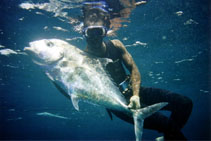Scyris alexandrina (GeoffroySaint-Hilaire, 1817)
Alexandria pompano
Uploaden van uw Foto's en video's
Pictures | Google afbeeldingScyris alexandrina
Picture by Camrrubi, J.-F.
Pictures | Google afbeeldingScyris alexandrina
Picture by Camrrubi, J.-F.
Gambia country information
Common names:
[No common name]
Occurrence: native
Salinity: marine
Abundance: | Ref:
Importance: | Ref:
Aquaculture: | Ref:
Regulations: | Ref:
Uses: no uses
Comments:
National Checklist:
Country Information: https://www.cia.gov/library/publications/resources/the-world-factbook/geos/ga.html
National Fisheries Authority:
Occurrences: Occurrences Point map
Main Ref: Bauchot, M.-L., 1987
National Database:
Occurrence: native
Salinity: marine
Abundance: | Ref:
Importance: | Ref:
Aquaculture: | Ref:
Regulations: | Ref:
Uses: no uses
Comments:
National Checklist:
Country Information: https://www.cia.gov/library/publications/resources/the-world-factbook/geos/ga.html
National Fisheries Authority:
Occurrences: Occurrences Point map
Main Ref: Bauchot, M.-L., 1987
National Database:
Common names from other countries
Classificatie / Names Lokale namen | Synoniemen | Catalog of Fishes(Genus, Soort(en)) | ITIS | CoL | WoRMS | Cloffa
Environment: milieu / climate zone / depth range / distribution range Ecologie
marien; diepte ? - 70 m (Ref. 2683). Subtropical; 42°N - 13°S, 19°W - 36°E
Verspreiding Landen | FAO regio's | Ecosystemen | Voorkomen | Point map | Introducties | Faunafri
Eastern Atlantic: off Morocco to Angola (Ref. 4225, 57392), including southern parts of the Mediterranean (Ref. 4225).
Grootte / Gewicht / Leeftijd
Maturity: Lm ? range ? - ? cm
Max length : 100.0 cm TL mannelijk / geslacht onbekend; (Ref. 27584); common length : 60.0 cm TL mannelijk / geslacht onbekend; (Ref. 3397); max. gepubliceerd gewicht: 3.2 kg (Ref. 40637)
Max length : 100.0 cm TL mannelijk / geslacht onbekend; (Ref. 27584); common length : 60.0 cm TL mannelijk / geslacht onbekend; (Ref. 3397); max. gepubliceerd gewicht: 3.2 kg (Ref. 40637)
Korte beschrijving Determinatiesleutels | Morfologie | Morfometrie
Dorsale stekels (totaal) : 8; Dorsale zachte stralen (totaal) : 20 - 22; Anale stekels: 3; Anale zachte stralen: 18 - 20. Diagnosis: body deep and strongly compressed, becoming elongate with growth (body depth comprised from 1.3 to 1.8 times in fork length); dorsal profile abrupt; mouth large, upper jaw ending below posterior half of eye; dorsal fin with 7 spines, becoming resorbed and indistinct at about 150 mm fork length, followed by 1 spine and 20-22 soft rays; anal fin with 2 spines, becoming resorbed and indistinct at very small sizes, followed by 1 spine and 18-20 soft rays; 1st dorsal- and anal-fin rays extremely long and filamentous in young individuals, becoming shorter in adults; pectoral fins falcate, longer than head; pelvic fins elongate in young individuals; scales very small and cycloid, hardly visible, absent on some parts of head and body; straight part of lateral line with 4-20 scutes; base of caudal fin with bilateral paired keels (Ref. 57392).
Coloration: silvery, with a faint metallic-blue tint on upper third of body and head; juveniles with 5 dark crossbars on sides (Ref. 57392).
Adults solitary in coastal water near the bottom to at least 50 m and strong swimmers (Ref. 7079, 57392). Juveniles usually pelagic and drifting, sometimes occurring in brackish water (Ref. 4225, 57392). Feed on squid and other fishes (Ref. 4233). Eggs are pelagic (Ref. 4233).
Levenscyclus en paargedrag Maturiteit | Voortplanting | Paaien | Eieren | Fecunditeit | Larven
Hoofdreferentie
Upload your references | Referenties | Coördinator : Smith-Vaniz, William F. | Medewerkers
Smith-Vaniz, W.F., J.-C. Quéro and M. Desoutter, 1990. Carangidae. p. 729-755. In J.C. Quero, J.C. Hureau, C. Karrer, A. Post and L. Saldanha (eds.) Check-list of the fishes of the eastern tropical Atlantic (CLOFETA). JNICT, Lisbon; SEI, Paris; and UNESCO, Paris. Vol. 2. (Ref. 7097)
Status op de Rode Lijst van het IUCN (Ref. 130435: Version 2024-2)
Niet bedreigd (LC) ; Date assessed: 09 May 2013
Gevaar voor de mens
Harmless
Gebruik door de mens
Visserij: van minder commercieel belang; sportvis: ja
FAO(visserij: productie; publication : search) | FishSource | Sea Around Us
Meer informatie
Population dynamics
Groeiparameters
Max. ages / sizes
Length-weight rel.
Length-length rel.
Lengtefrequenties
Massaconversie
Rekrutering
Abundantie
Groeiparameters
Max. ages / sizes
Length-weight rel.
Length-length rel.
Lengtefrequenties
Massaconversie
Rekrutering
Abundantie
Life cycle
Voortplanting
Maturiteit
Fecunditeit
Paaien
Spawning aggregations
Eieren
Ontwikkeling van de eieren
Larven
Larvale populatiedynamiek
Voortplanting
Maturiteit
Fecunditeit
Paaien
Spawning aggregations
Eieren
Ontwikkeling van de eieren
Larven
Larvale populatiedynamiek
Anatomy
Kieuwoppervlak
Brain
Otolith
Kieuwoppervlak
Brain
Otolith
Physiology
Body composition
Nutrients
Zuurstofverbruik
Zwemtype
Zwemsnelheid
Visual pigments
Fish sound
Diseases & Parasites
Toxicity (LC50s)
Body composition
Nutrients
Zuurstofverbruik
Zwemtype
Zwemsnelheid
Visual pigments
Fish sound
Diseases & Parasites
Toxicity (LC50s)
Genetics
Genetica
Heterozygosity
Erfelijkheid
Genetica
Heterozygosity
Erfelijkheid
Human related
Aquaculture systems
Aquacultuurprofielen
Kweeklijnen
Ciguatera cases
Stamps, coins, misc.
Aquaculture systems
Aquacultuurprofielen
Kweeklijnen
Ciguatera cases
Stamps, coins, misc.
Tools
E-boek | Veldgids | Lengtefrequentie Tool | Levenscyclus tool | Verspreidingskaart | Classification Tree
| Catch-MSY |
Speciale rapporten
Bekijk gegevens voor het houden in een aquarium | Bekijk Fact Sheets voor de soort | Bekijk Aquacultuur Fact Sheets
Download XML
Internetbronnen
Aquatic Commons | BHL | Cloffa | Websites from users | Bekijk FishWatcher | CISTI | Catalog of Fishes(Genus, Soort(en)) | DiscoverLife | ECOTOX | Faunafri | Fishtrace | GenBank(genoom, nucleotide) | GloBI | GOBASE | | Google Books | Google Scholar | Google | IGFA World Record | MitoFish | Nationale databanken | Otolith Atlas of Taiwan Fishes | PubMed | Reef Life Survey | Scirus | SeaLifeBase | Tree of Life | Wikipedia(ga naar, zoek) | World Records Freshwater Fishing | Zoological Record
Estimates based on models
Preferred temperature (Ref. 115969): 18.6 - 27.9, mean 24.4 (based on 150 cells).
Fylogenetische diversiteitsindex (Ref. 82804): PD50 = 0.6250 [Uniqueness, from 0.5 = low to 2.0 = high].
Bayesian length-weight: a=0.02512 (0.01384 - 0.04557), b=2.83 (2.68 - 2.98), in cm Total Length, based on LWR estimates for this species & (Sub)family-body (Ref. 93245).
Trofisch niveau (Ref. 69278): 3.6 ±0.59 se; based on food items.
Weerstandsvermogen (Ref. 120179): Gemiddeld, minimale populatieverdubbelingstijd 1,4-4,4 jaar (Assuming tm=3-4).
Fishing Vulnerability (Ref. 59153): High vulnerability (60 of 100).
Climate Vulnerability (Ref. 125649): High to very high vulnerability (69 of 100).




